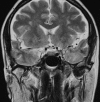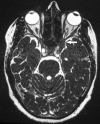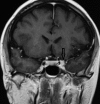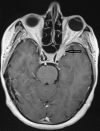Tolosa-Hunt Syndrome Demonstrated by Constructive Interference Steady State Magnetic Resonance Imaging
- PMID: 28299013
- PMCID: PMC5340048
- DOI: 10.4103/2008-322X.200171
Tolosa-Hunt Syndrome Demonstrated by Constructive Interference Steady State Magnetic Resonance Imaging
Abstract
Purpose: To highlight the role of constructive interference steady state (CISS) magnetic resonance imaging (MRI) in the diagnosis of Tolosa-Hunt Syndrome (THS).
Case report: We describe a case of THS in a 55-year-old woman presenting with left painful opthalmoplegia that was diagnosed by CISS MRI. Patient responded to steroid treatment and the lesion resolved.
Conclusion: Imaging with MRI can help in making the diagnosis of THS by demonstrating an enhancing soft tissue lesion in the cavernous sinus and orbital apex resolving with steroids. CISS MRI is a sensitive sequence for diagnosis and follow-up imaging in THS.
Keywords: Cavernous Sinus; Constructive Interference Steady State Magnetic Resonance Imaging; Painful Ophthalmoplegia; Tolosa-Hunt Syndrome.
Conflict of interest statement
There are no conflicts of interest.
Figures




Similar articles
-
A case report on recurrent alternating Tolosa-Hunt syndrome due to bacterial sphenoid sinusitis: rediscussing the diagnostic terminology and classification.BMC Neurol. 2023 Jan 17;23(1):25. doi: 10.1186/s12883-023-03067-z. BMC Neurol. 2023. PMID: 36650509 Free PMC article.
-
Steroid responsive cavernous sinus syndrome due to Rosai-Dorfman disease: beyond Tolosa-Hunt syndrome - a case report.BMC Neurol. 2021 Jul 5;21(1):264. doi: 10.1186/s12883-021-02255-z. BMC Neurol. 2021. PMID: 34225703 Free PMC article.
-
Tolosa-Hunt syndrome due to actinomycosis of the cavernous sinus: the infectious hypothesis revisited.Headache. 2004 Sep;44(8):806-11. doi: 10.1111/j.1526-4610.2004.04149.x. Headache. 2004. PMID: 15330828
-
Tolosa-Hunt Syndrome: Clinical Manifestations in Children.Pediatr Neurol. 2019 Oct;99:60-63. doi: 10.1016/j.pediatrneurol.2019.02.013. Epub 2019 Feb 20. Pediatr Neurol. 2019. PMID: 30982655 Review.
-
Tolosa-Hunt syndrome: focus on MRI diagnosis.Cephalalgia. 1999 Dec;19 Suppl 25:36-8. doi: 10.1177/0333102499019s2509. Cephalalgia. 1999. PMID: 10668118 Review.
Cited by
-
Advances in magnetic resonance imaging of orbital disease.Can J Ophthalmol. 2022 Aug;57(4):217-227. doi: 10.1016/j.jcjo.2021.04.025. Epub 2021 May 28. Can J Ophthalmol. 2022. PMID: 34058140 Free PMC article.
-
Tolosa-Hunt Syndrome: A Review of Diagnostic Criteria and Unresolved Issues.J Curr Ophthalmol. 2021 Jul 5;33(2):104-111. doi: 10.4103/joco.joco_134_20. eCollection 2021 Apr-Jun. J Curr Ophthalmol. 2021. PMID: 34409218 Free PMC article. Review.
-
Tolosa Hunt Syndrome: MRI Findings.Cureus. 2023 Oct 7;15(10):e46635. doi: 10.7759/cureus.46635. eCollection 2023 Oct. Cureus. 2023. PMID: 37936989 Free PMC article.
References
-
- Zhang X, Zhou Z, Steiner TJ, Zhang W, Liu R, Dong Z, et al. Validation of ICHD-3 beta diagnostic criteria for 13.7 Tolosa-Hunt syndrome: Analysis of 77 cases of painful ophthalmoplegia. Cephalalgia. 2014;34:624–632. - PubMed
-
- Okawa S, Hanazono A, Sugawara M, Takahashi S, Otani T, Hanyu N, et al. Contrast-enhanced 3D FIESTA imaging in Tolosa-Hunt syndrome. Headache. 2012;52:822–824. - PubMed
-
- Jain R, Sawhney S, Koul RL, Chand P. Tolosa-Hunt syndrome: MRI appearances. J Med Imaging Radiat Oncol. 2008;52:447–451. - PubMed
-
- Kwan ES, Wolpert SM, Hedges TR, 3rd, Laucella M. Tolosa-Hunt syndrome revisited: Not necessarily a diagnosis of exclusion. AJNR Am J Neuroradiol. 1987;8:1067–1072. - PubMed
Publication types
LinkOut - more resources
Full Text Sources
Other Literature Sources
Miscellaneous

